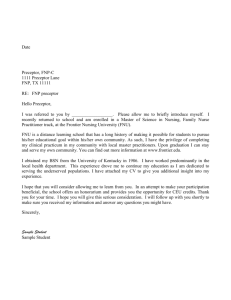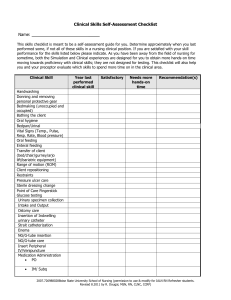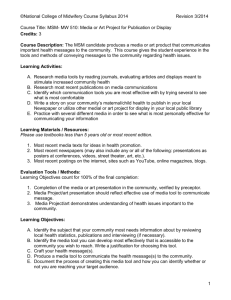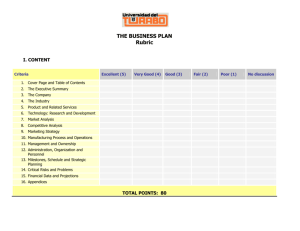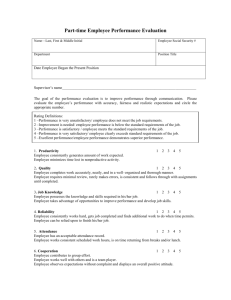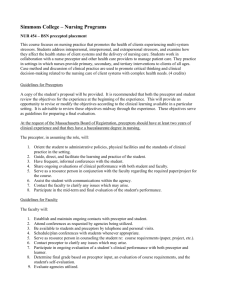McMaster Mohawk Conestoga BScN Program PRECEPTOR: Level
advertisement
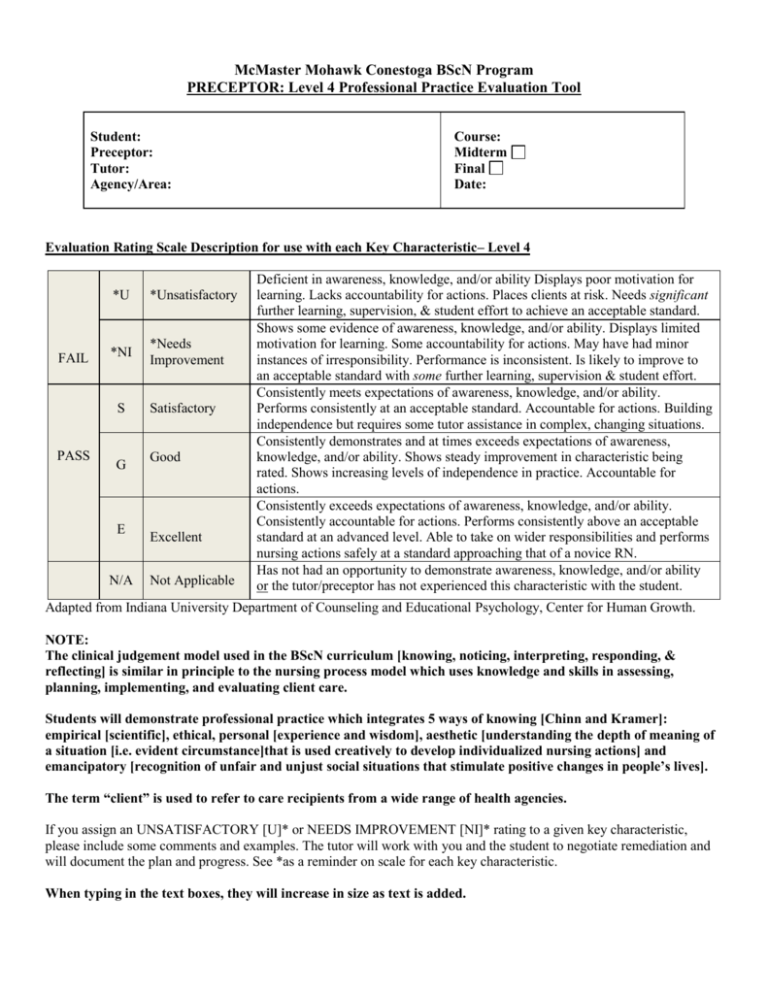
McMaster Mohawk Conestoga BScN Program PRECEPTOR: Level 4 Professional Practice Evaluation Tool Student: Preceptor: Tutor: Agency/Area: Course: Midterm Final Date: Evaluation Rating Scale Description for use with each Key Characteristic– Level 4 FAIL PASS *U *Unsatisfactory *NI *Needs Improvement S Satisfactory G E N/A Good Excellent Not Applicable Deficient in awareness, knowledge, and/or ability Displays poor motivation for learning. Lacks accountability for actions. Places clients at risk. Needs significant further learning, supervision, & student effort to achieve an acceptable standard. Shows some evidence of awareness, knowledge, and/or ability. Displays limited motivation for learning. Some accountability for actions. May have had minor instances of irresponsibility. Performance is inconsistent. Is likely to improve to an acceptable standard with some further learning, supervision & student effort. Consistently meets expectations of awareness, knowledge, and/or ability. Performs consistently at an acceptable standard. Accountable for actions. Building independence but requires some tutor assistance in complex, changing situations. Consistently demonstrates and at times exceeds expectations of awareness, knowledge, and/or ability. Shows steady improvement in characteristic being rated. Shows increasing levels of independence in practice. Accountable for actions. Consistently exceeds expectations of awareness, knowledge, and/or ability. Consistently accountable for actions. Performs consistently above an acceptable standard at an advanced level. Able to take on wider responsibilities and performs nursing actions safely at a standard approaching that of a novice RN. Has not had an opportunity to demonstrate awareness, knowledge, and/or ability or the tutor/preceptor has not experienced this characteristic with the student. Adapted from Indiana University Department of Counseling and Educational Psychology, Center for Human Growth. NOTE: The clinical judgement model used in the BScN curriculum [knowing, noticing, interpreting, responding, & reflecting] is similar in principle to the nursing process model which uses knowledge and skills in assessing, planning, implementing, and evaluating client care. Students will demonstrate professional practice which integrates 5 ways of knowing [Chinn and Kramer]: empirical [scientific], ethical, personal [experience and wisdom], aesthetic [understanding the depth of meaning of a situation [i.e. evident circumstance]that is used creatively to develop individualized nursing actions] and emancipatory [recognition of unfair and unjust social situations that stimulate positive changes in people’s lives]. The term “client” is used to refer to care recipients from a wide range of health agencies. If you assign an UNSATISFACTORY [U]* or NEEDS IMPROVEMENT [NI]* rating to a given key characteristic, please include some comments and examples. The tutor will work with you and the student to negotiate remediation and will document the plan and progress. See *as a reminder on scale for each key characteristic. When typing in the text boxes, they will increase in size as text is added. Required parameters are missing or incorrect. Theme: Personhood and Caring Key Characteristic: Communication & Relational Skills Demonstrates awareness and use of personal communication style and impact of self in interactions with clients and all others. Engages in meaningful and confidential dialogue with clients to establish a client centred care plan considering clients unique needs. Provides timely client/TOA updates in an organized, concise manner to preceptor and other team members. Accurately documents nursing activities in a timely manner. Adheres to standards, guidelines, policies, and as authorized/recommended by the agency Check one: Unsatisfactory Needs Improvement Satisfactory Good Excellent N/A Comments and Examples: Key Characteristic: Caring Uses a humanistic approach to caring emphasizing dignity, compassion, empathy, concern for client, family and community needs (where appropriate). Demonstrates consistent evidence of scientific [research-based] and humanistic [art-of-nursing] caring which serves as the basis for the provision of high quality health and related care. Check one: Unsatisfactory Needs Improvement Satisfactory Good Excellent N/A Comments and Examples: Key Characteristic: Client-Centred Care Understands the client story(ies)/narrative(s)/ reflecting theory, supporting rationale and multiple ways of knowing. Views the client in a holistic manner, seeing the client as a person with needs and assets, not a disorder or disease that needs to be treated. Includes the client, as well as, family/friends, relevant stakeholders, where appropriate as members of the health team. Responds in a timely manner to client needs. Develops therapeutic, culturally sensitive nurse-client relationships and provides non-judgemental nursing care, while respecting the client’s story, cultural norms, values and beliefs. Check one: Unsatisfactory Needs Improvement Satisfactory Good Excellent N/A Comments and Examples: Key Characteristic: Professionalism Displays increasing autonomous, safe practice according to standards, legislation, guidelines, policies, and procedures. Models professional accountability and responsibility. Is punctual and prepared to engage in professional practice, including preceptor-tutor-student meetings. Demonstrates integrity in all aspects of professional practice and educational endeavours. Displays honesty and accepts responsibility for own actions and decisions, including errors and near misses. Demonstrating increasing confidence in nursing judgement [knowing, noticing, interpreting, responding, reflecting]. Refining a professional identity and sense of who they are as a nurse while demonstrating values and behaviours consistent with professional practice. Check one: Unsatisfactory Needs Improvement Satisfactory Good Excellent N/A Comments and Examples: Level 4 Professional Practice Evaluation Tool – PRECEPTOR May 2013 Version Required parameters are missing or incorrect. Theme: Context, Health, and Healing Key Characteristic: Professional Practice Skill Development Knowing and Acting: Uses clinical reasoning based on sound principles and/or rationale. Recognizes limitations and seeks assistance in situations that are beyond one’s capabilities. Provides care within the context of a client-centred philosophy and within the parameters of the agency’s nursing standards, practice guidelines, policies and procedures. Judgement: Recognizes and uses available learning opportunities to rehearse and develop professional practice. Accepts feedback from key resources [preceptor, other team members, tutor, peers] and modifies behaviour to improve performance. Being and Becoming: Interventions are client-centered, recognizing the significance of client respect, choice and informed consent. Evidence of the process of transition from student nurse to practising professional. Check one: Unsatisfactory Needs Improvement Satisfactory Good Excellent N/A Comments and Examples: Key Characteristic: Client/Nurse Safety and Care Quality Understands the importance of client safety and role of the nurse and other team members. Applies and maintains vigilance for client, self, and team member safety, using protective and preventive health measures. Questions unclear orders, decisions, or actions made by any member of the team. Recognizes situations of unsafe practice, near misses, and errors, risk factors that impact client, self or team member. Takes timely action to stop and minimize harm; recognizes, seeks immediate assistance/guidance in situations where changing conditions and factors could affect the client’s health/safety. Check one: Unsatisfactory Needs Improvement Satisfactory Good Excellent N/A Comments and Examples: Key Characteristic: Advocacy & Leadership Identifies and advocates concerns/needs of clients and family, community, or population, with appropriate collaboration, reporting, and documentation. Provides relevant client education and information related to health and self-care/community-care. Protects client safety, privacy, autonomy, and right to choose. Beginning to identify opportunities for leading at point of care [by nurse from the bedside]. Check one: Unsatisfactory Needs Improvement Satisfactory Good Excellent N/A Comments and Examples: Key Characteristic: Inter-professional Collaboration and Teamwork Recognizes, understands, and values different roles and ideas/opinions of inter professional team. Anticipates and determines need for team participation, collaboration, and decision-making in planning familycentered/client care. During situations of inter-professional conflict demonstrates professional communication/collaboration skills. Assumes effective role within IP team to accomplish client care goals. Takes initiative and participates confidently in team collaboration. Demonstrates awareness for organizational/system issues that impact the quality of client care. Check one: Unsatisfactory Needs Improvement Satisfactory Good Excellent N/A Comments and Examples: Key Characteristic: Energy, Time Management, and Organization Level 4 Professional Practice Evaluation Tool – PRECEPTOR May 2013 Version Required parameters are missing or incorrect. Demonstrates increasing organization and efficiency in providing safe, nursing care. Prioritizes appropriately when caring for one or more clients with complex needs, or a community/population as the client. Practices with greater autonomy, as agreed upon with the preceptor. Demonstrates increasing ability to be flexible, resilient, and able to manage in situations involving change. Demonstrates increasing ability to effectively manage ethical dilemmas and moral distress. Recognizes the importance of self-care, work, and personal life balance to enable successful inter-professional working relationships and positive client outcomes. Check one: Unsatisfactory Needs Improvement Satisfactory Good Excellent N/A Comments and Examples: Theme: Learning and Knowing Key Characteristic: Clinical Reasoning & Judgment Knowing and Noticing: Understands the client’s story. Completes accurate and comprehensive client assessments. Develops a client-centered care plan, evaluating it on an ongoing basis. Anticipates client’s outcomes, based on prior knowledge, experience, and individual learning and preparation for the student’s client(s) assignment [or the identified client population]. Demonstrates awareness of how external (socio-political) and internal factors can impact self and influence care of clients with increasing complexity. Interpreting: Demonstrates adequate understanding and ability to interpret client information (eg. laboratory results, diagnostic findings, epidemiological trends and community knowledge) in situations of complexity and high client acuity. Uses clinical reasoning and judgement to identify, prioritize, and implement sound nursing interventions. Continuously evaluates and adapts interventions based on the client’s story, changes in health needs, and health care environment. Responding to information: Prioritizes actual and anticipated client care needs. Effectively utilizes team and community/system resources. Modifies interventions in response to client and family care needs in different situations. Applies humanistic and scientific caring to nursing actions. Reflecting, In action: Notices client’s response to nursing interventions and adjusts appropriately with preceptor. Engages in self-reflection with respect to nursing practice and client outcomes. On action: Reflects on learning from client care experience, and discusses how ongoing knowledge and professional development contribute to nursing judgement in future situations. Examines inferences, assumptions, issues, and beliefs as a way of improving one’s professional practice and developing a personal wisdom base. Check one: Unsatisfactory Needs Improvement Satisfactory Good Excellent N/A Comments and Examples: Key Characteristic: Knowledge Generation, Utilization and Dissemination Demonstrates a spirit of inquiry about new knowledge and technologies that inform decision-making at the bedside. Retrieves, analyzes, interprets, synthesizes, and applies knowledge from scientific and/or best practice evidences as authorized/recommended by the agency. Demonstrates intellectual courage and willingness to listen and respect values, ideas, and beliefs of others. Demonstrates intellectual humility by knowing/accepting one’s limitations, prejudices, biases. Check one: Unsatisfactory Needs Improvement Satisfactory Good Excellent N/A Comments and Examples: Key Characteristic: Learning and Teaching Level 4 Professional Practice Evaluation Tool – PRECEPTOR May 2013 Version Required parameters are missing or incorrect. Actively participates in learning/teaching with preceptor, peers, and other health care team members. Engages in sharing knowledge/resources, providing constructive feedback, and facilitating discussions to enable positive client outcomes, and healthy work environments. Participates in health promotion/prevention with the client/family, community/population when establishing a mutually agreed upon care plan, considering and understanding the impact of cultural diversity and determinants of health [smoking, alcohol, drug abuse, poverty]. Recognizes members of the “community of professional practice” as sources of learning and ongoing personal and professional development. Accepts constructive feedback, viewing it as a positive mechanism that enables continuous improvement and growth. Check one: Unsatisfactory Needs Improvement Satisfactory Good Excellent N/A Comments and Examples: Level 4 Professional Practice Evaluation Tool – PRECEPTOR May 2013 Version Required parameters are missing or incorrect. Factors [context] that should be considered in conjunction with this evaluation [e.g. unexpected occurrences, absences]: Strengths and Areas for Growth, Including Suggested Strategies Areas for Growth/Suggested Strategies: Strengths: Next Steps: Recommended Level of Performance (check one): Midterm Progressing towards meeting course ends in view Failing Final Pass Fail __________________________ Preceptor Signature ______________________ Student Signature ______________________ Tutor Signature __________________________ Date ______________________ Date ______________________ Date Level 4 Professional Practice Evaluation Tool – PRECEPTOR May 2013 Version
